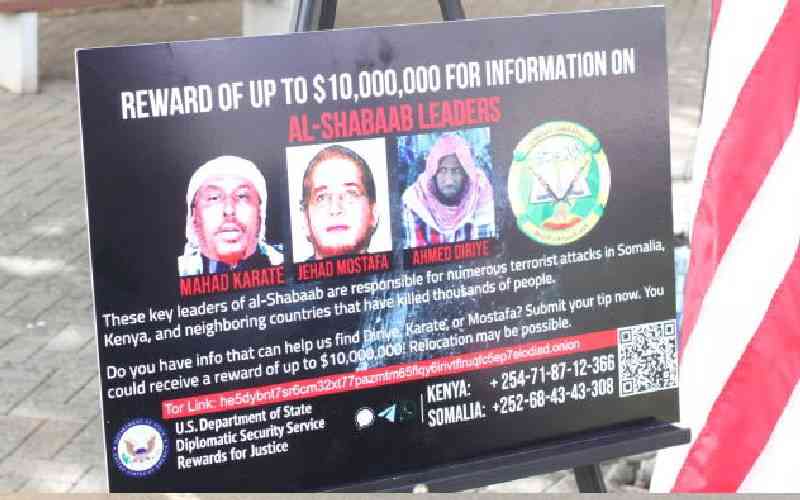MOMBASA: Kenya’s security establishment believed early last year that radical Islamist Sheikh Sharif Abubakar alias Makaburi ordered the murder of moderate Muslim preachers before he was shot and killed on April 1 last year, according to leaked spy cables.
This assessment is contained in a document dated March 5, 2014 sent by the National Police Service to key police formations across Kenya. Makaburi was killed less than a month later in broad daylight outside Shanzu Law Courts in Mombasa.
One document regarded Makaburi as a mortal threat with international terrorism links and proposed prosecution of radicals but also floated an idea to “intensify security measures on those behind radicalisation” after, purportedly uncovering the dangers of radical Islamism to the continued existence of the Kenya nation state.
The documents sought to explain the alleged growing dangers of radical Islamism among vulnerable youths and its capacity to bread terrorism across Kenya and recommended vigilance and security measures and surveillance.
Makaburi, allegedly, ordered the killings after accusing the two preachers allied to the Council of Imams and Preachers of Kenya of betraying the Muslim cause.
The cables obtained by Al Jazeera channel expose the establishment’s extreme paranoia about the activities of Makaburi who was placed on a US and UN sanctions’ list in July 2012 alongside slain comrade Sheikh Aboud Rogo Mohamed.
The revelations are likely to generate animosity between Makaburi’s supporters and the CIPK due to the claim that Makaburi plotted to murder two CIPK imams after orchestrating eviction of moderate imams from certain mosques in Mombasa and also ignite questions about the accuracy of the intelligence that led to the assessment and conclusions.
Additionally, the documents indicate the security authorities under the new Jubilee administration, has a soft spot for CIPK considering it a moderate group.
Top police officers depend on it to offer “the correct interpretation of the Quran with regard to jihad” and to assist security authorities to combat Makaburi’s influence among so-called Wahhabi/Salafist adherents.
The documents which tend to equate Islamic radicalism and terrorism will fuel new questions about who killed Sheikh Mohamed Idriss, the slain chairman of the CIPK who died mid-June last year after being ousted as imam of Sakina Mosque by radical youth.
Questions will also arise about whether police ever enhanced security for the allegedly targeted imams or if they questioned Makaburi after claiming he was planning to kill certain imams.
“He has directed that Sheikh (name withheld) and.... Both members of the Supreme Council of Imams and Preachers and who are perceived to be moderate, to be assassinated for alleged betrayal of the ‘Muslim’ cause...,” says a March 5, 2014 document by the National Police Service to police stations in Nairobi, Mandera, Mombasa, Marsabit, Lamu, Kisii and Garissa where, presumably the terrorist threat from Makaburi and his associates was growing.
It is presumed the Supreme Council of Imams and Preachers of Kenya refers to CIPK because the author used the abbreviation CIPK in brackets after writing about the organisation.
But despite relying on CIPK to counter Makaburi and his legion of followers around Musa Mosque in Mombasa, the security establishment discovered that the so-called moderates were just lukewarm in support of the government’s effort to neutralise the radicals and their ideology.
Stay informed. Subscribe to our newsletter
According to several documents, Makaburi was in the eyes of the police, guilty of all sorts of crimes including plotting the ouster of moderate imams and preachers in Mombasa and Coast region, fanning an Islamist uprising in Kenya and abroad and orchestrating the February 2, 2014 jihadist convention at Musa Mosque in Mombasa.
The episode ended in bloody confrontation when police stormed the mosque leading to the death of five worshippers and a policeman.
In the February 2, 2014 raid, according to these documents, police captured 129 people “among them 21 minors” and recovered weapons and three laptops whose contents were never disclosed.
A man arrested at the mosque has disappeared to date and judge has ordered an inquest into his disappearance.
Significantly, Makaburi was killed outside the court after bailing out suspects detained from the mosque raid.
In the March 5, 2014 document, police disclose the State’s preferences for CIPK in the matter of combating radicalisation in Mombasa and at the Coast.
It states that police or security agencies sought to fight the radicals in “partnership with the Council of Imams and Preachers of Kenya to give the correct interpretation of the Quran with regard to jihad.”
The author said there were many obstacles against the State’s efforts to combat radicalisation and terrorism including lack of logistics and remoteness of target areas in Kwale, Isiolo and other towns but also warned that so-called moderates had not demonstrated willingness to face Makaburi.
“There is increasing apathy among Muslim moderates and leadership on how best to address the problem of radicalisation, which is further compounded by the lukewarm approach of...(moderate organisations)... on radicalisation and the preaching of jihadism.”
In document, Makaburi was declared to be “a possible financier of radicalisation and the link to other Al Qaida outfits in the region,” and warned that there were 12 other extremist preachers lurking around Mombasa or the Coast.
Meanwhile, a document from the National Police Service on April 29 (after Makaburi’s death) warned that his followers were planning to avenge his death with “revenge attacks” in Nairobi and Mombasa.
It also said that Al Shabaab had inserted operatives from abroad travelling on falsified Kenyan ID cards to execute the act. The document suggests that this fear was the motive behind Operation Usalama Watch in Nairobi and Mombasa.
 The Standard Group Plc is a
multi-media organization with investments in media platforms spanning newspaper
print operations, television, radio broadcasting, digital and online services. The
Standard Group is recognized as a leading multi-media house in Kenya with a key
influence in matters of national and international interest.
The Standard Group Plc is a
multi-media organization with investments in media platforms spanning newspaper
print operations, television, radio broadcasting, digital and online services. The
Standard Group is recognized as a leading multi-media house in Kenya with a key
influence in matters of national and international interest.
 The Standard Group Plc is a
multi-media organization with investments in media platforms spanning newspaper
print operations, television, radio broadcasting, digital and online services. The
Standard Group is recognized as a leading multi-media house in Kenya with a key
influence in matters of national and international interest.
The Standard Group Plc is a
multi-media organization with investments in media platforms spanning newspaper
print operations, television, radio broadcasting, digital and online services. The
Standard Group is recognized as a leading multi-media house in Kenya with a key
influence in matters of national and international interest.








